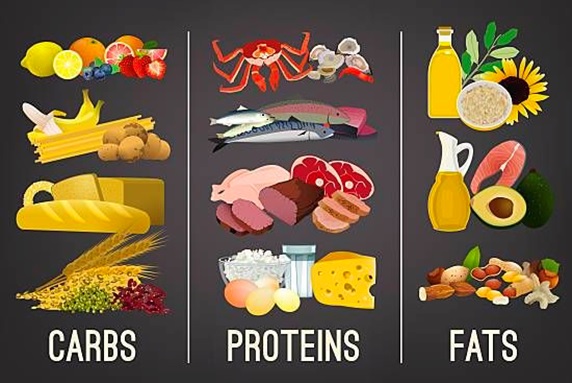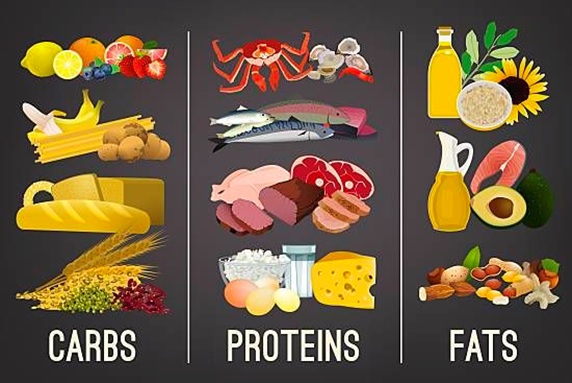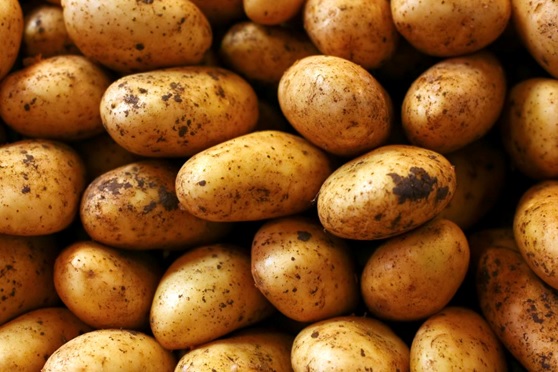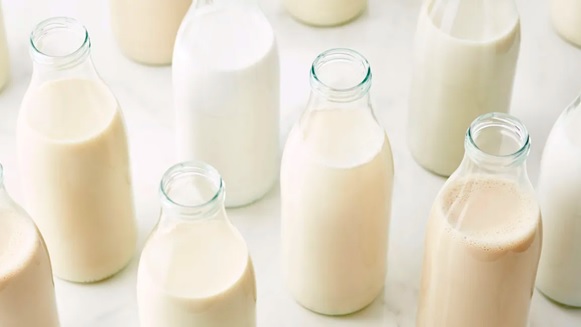
The nutrition world is full of jargon. It’s no wonder so many of us don’t know what we should be eating. Figuring out what the words on our food labels mean is a task in itself. Well fear not, this article will help you out. Read below to learn ten interesting nutrition terms and what they mean. Familiarising yourself with these words will help you make more informed food decisions. Learn the vernacular and you’ll be a nutrition whizz in no time.
#1 - Macronutrients
Macronutrients or ‘macros’ refers to proteins, carbohydrates and fats. These are the three main nutrients that give your body energy in the form of calories. It is essential that we consume these through diet because our bodies are not able to create them on their own. If you don’t consume the right amount of protein, carbs and fats for you, your body won’t function optimally. All foods contain at least one macro but some are a combination of two or all. For example, olive oil is 100% fat. Asparagus on the other hand is a combination of carbohydrates, proteins and fats. Your macronutrient requirements depend on factors like lifestyle, bodyweight, gender and age. Finding an ideal macro split for you will require a bit of trial and error. The more you train, the more carbohydrates you need. The older you are, the more protein you’ll require. There are many factors at play but it’s generally recommended to avoid diets that eliminate entire macronutrient groups. Even if they help you with fat loss in the short term, they likely won’t be enjoyable or easy to sustain. For optimal health, eat a varied diet that includes a good balance of all three macronutrients.

#2 - Satiating
Satiating comes from the Latin word satis which means “enough”. If something is satiating, it means it makes you feel full. A common problem many people experience is they don’t eat foods that satisfy them. This leads to intense feelings of hunger and deprivation. To combat that feeling of being ravenous, you should pick foods that rank highly on the satiety index. According to research, the most satiating foods are potatoes, eggs, oats, greek yoghurt, cottage cheese, vegetables and the like. Anything high in fibre or protein will trigger your body’s fullness cues and make you feel satiated. Processed foods like lollies and chips might taste good in the short term, but they don’t contain nutrients that will invoke satiety.

#3 - Gluten
So many people these days aim to eat a gluten free diet but don’t actually know what it is. Gluten is a type of protein found in foods like wheat, rye and barley. It really should be called GLUE-ten because it acts as a binding agent to hold foods together. It is present in most pastas, breads and cereals however there are a plethora of gluten free options available on the market today. People with coeliac disease should avoid gluten like the plague because their bodies are essentially allergic. Even a tiny amount can cause severe abdominal pain and bloating. Those without coeliac disease can usually consume gluten without experiencing any ill-effects. If you have been told to avoid gluten for the purposes of fat loss or health, make sure you consult with some other professionals first. Gluten is frequently demonised for no good reason. If you’re genuinely celiac, then definitely stick to a gluten free diet. However if you have no identified intolerance and enjoy a bit of pasta without any negative side effects, feel free to continue what you’re doing.

#4 - Calories
Calories are simply a unit of measurement like a centimetre or a mile. They represent the amount of energy contained in a food or beverage. For example, a scoop of protein powder is usually around 120 calories and a can of Coke contains 150. We all need a certain number of calories in a day to fuel our physical activity. Eating more calories than we need results in weight gain and eating too little will have you feeling depleted and malnourished. You probably know people who use calorie counting as a way to keep track of energy intake. This is just one of many food monitoring methods. It works for some and isn’t ideal for others. In New Zealand, we use the metric system so kilojoules (kj) typically get used on food labels instead of calories. 1 cal = 4.2kj so if you ever need to convert, roughly divide kilojoules by four.
#5 - Bioavailable
Bioavailability refers to how well your body is able to efficiently extract the nutrients from the foods you eat. If something is particularly bioavailable, it will be easily absorbed by your digestive system and transported around your body. This applies to the foods you eat, the medicines you take and the supplements you use. A product that is very bioavailable is also highly effective. This is why many choose whey isolate over plant protein powders. Whey isolate has a digestibility score of 100 compared to pea protein which is only 88. This doesn’t mean pea protein isn’t worth taking. It just means you may need to consume more of it to make up for the small amount that your body is unable to absorb.

#6 - Fibre
You’ve probably been told that getting sufficient fibre is essential for digestive health but why? Fibre is a carbohydrate typically found in plant based foods like psyllium husks. Unlike other carbs, fibre doesn’t contain any calories. This is because it never actually gets absorbed by the body. Rather than entering your bloodstream like other nutrients do, fibre passes straight through your intestines and is eventually excreted. Increasing fibre intake can help mitigate hunger and cure constipation. If you’re feeling a bit blocked up, try eating foods like broccoli, popcorn or beans. Anything with a bit of roughage can help move things along in your digestive tract. It is recommended that men get around 30g of fibre per day and 25g for women. Too much of it results in stomach pain but too little will have you feeling hungry and constipated. Like with anything, aim to consume a moderate amount that leaves you feeling good.

#7 - Ad Libitum
Ad libitum feeding basically means you have access to food at all times and aren’t under any restrictions. This esoteric phrase comes from Latin and translates to “at one’s pleasure”. You will commonly see these words used in nutrition studies to describe research participants who are permitted to eat whatever they want, whenever they want. Interestingly but not surprisingly, studies show that rats who are allowed to eat ad libitum are more likely to suffer health issues compared to rats on a restricted diet. This is not good news for the gluttons of the world. It turns out that eating whatever your heart desires tends to result in obesity, high blood pressure and a shorter lifespan. A bit of restriction can actually be a good thing. Although we might want to spend our lives munching our favourite foods, we know this will not help us achieve optimal health. Remember that you can have anything you want, but not everything you want. Eating ad libitum sounds fun in theory but the long term health effects are not worth the short term gluttonous pleasure.
#8 - Micronutrients
The term ‘micronutrients’ refers to vitamins and minerals. They are the things we need in small doses to keep our body running optimally. Unlike macronutrients which we need in large quantities, micronutrients are only needed in trace amounts. Some examples include the vitamin C found in citrus fruits or the vitamin D we get from the sun. It is vital we get the right amount of each micronutrient in order to avoid deficiency. If you underdo it on the vitamin A you will experience dry skin and poor vision. Insufficient magnesium can give you muscle spasms and fatigue. These kinds of deficiencies are no joke and can have long term effects. The best way to avoid missing out on micronutrients is to consume a wide array of foods or even a greens powder if you are desperate. As they say, variety is the spice of life. Make sure to include a few different fruits and vegetables in your regular diet. Doing so is the best way to ensure your body is getting all of the good stuff it needs for peak performance.

#9 - Lactose
You likely know someone who is lactose intolerant but what does that actually mean? Lactose is a sugar found in dairy products like milk. The biology nerds out there will know that it is a disaccharide, meaning it is composed of two sugar molecules (glucose and galactose). In order to digest and use lactose for energy, your body uses an enzyme called lactase. Unfortunately two thirds of humans lack this enzyme which is why many of us don’t feel great after drinking a cup of milk. Symptoms of lactose intolerance diarrhoea, bloating, sore stomach and bad farts. If this is you, go for lactose free products like plant-based protein powder or try a lactase supplement. Taking exogenous lactase can help your body break down the sugars found in milk and mitigate negative side effects.

#10 - Diet
Our final term on the list is “diet”. Usually this word connotes ideas of restricting one’s food intake or low calorie products but this is a bit reductive. Diet actually encompasses the entirety of the food and beverages you regularly consume on a day to day basis. It is interesting that people say they are “going on a diet” because technically they are already on one. Regardless of whether or not you follow a specific nutrition protocol, all of us eat and drink every day. The various things we choose to consume comprise our overall diet. We might think that we are in charge of our dietary choices but a lot of it is culturally influenced. We learn what to eat from our parents, friends and society. Diets vary across cultures and a typical breakfast for one person might seem totally strange to another. The next time you hear the word diet, remember that it could be referring to a low calorie product or it could be talking about someone’s overall way of eating.

Conclusion
Hopefully this article cleared up confusion and taught you some new words to add to your lexicon. The nutrition space is full of hard to understand terminology that can leave the average person feeling lost and unsure. Knowledge is power and the more we know about the foods we eat, the better. The next time you encounter a confusing term, empower yourself by looking up the definition. There is no such thing as having too many words in your vocabulary.
Written by Lauren Carruthers
